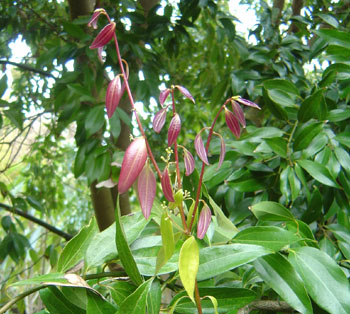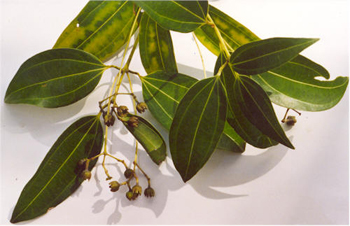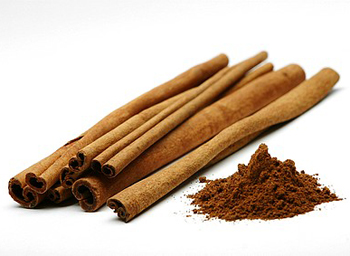Contents:
Common Names | Parts Usually Used | Plant(s) & Culture | Where Found | Medicinal Properties | Biochemical Information
Legends, Myths and Stories | Uses | Formulas or Dosages | How Sold | Warning | Resource Links | Bibliography
Scientific Names

- Cinnamomum zeylanicum L.
- Lauraceae
- Laurel family
Common Names
- Gui (Chinese name)
- Twak (Sanskrit name)
- Yueh-kuei
Parts Usually Used
Bark, oil obtained from bark and leaves
Back to Top

Description of Plant(s) and Culture
The dried inner bark of the branches of a small, tropical, evergreen laurel tree. The bark is peeled off and as the pieces are dried, they curl up into quills.
Back to Top
Where Found
Found growing around marshes.
Back to Top
Medicinal Properties
Stimulant, alterative, analgesic, aromatic, astringent, carminative, diaphoretic, diuretic, expectorant, febrifuge, mild laxative
Back to Top
Biochemical Information
Essential oil including phellandrene, eugenol, gums, sugar, coumarins, cinnamic aldehyde, methuleugenol; mucilage, tannin, sucrose and starch
Back to Top

Legends, Myths and Stories
Cinnamon was probably the first spice used by man. Ancient records reveal that it was used for more than 5,000 years. The countless flavoring uses of this valuable spice need not be enumerated.
Cinnamon brandy is made by soaking crushed cinnamon bark a fortnight in brandy.
In the Far East, the cinnamon tree is grown in southern China, but is native to Kuangsi. Since ancient times, cinnamon has been used as medicine and the flavoring spice we know today.
Cinnamon has long been used to cure everything from athlete’s foot to indigestion. Early civilizations recognized its ability to stop bacterial growth. The Egyptians used it in embalming. During the Middle Ages, it was mixed with cloves and warm water, and placed in the sick rooms of victims of the Bubonic Plague.
Recent research indicates that cinnamon can have favorable effects on brain function. Participants in a study chewed cinnamon gum or smelled the sweet spice. Cognitive tests revealed that subjects who used cinnamon had better memory functions and could process information more quickly. Encouraged by these findings, scientists will now conduct studies to see if cinnamon will improve mental skills in the elderly and those prone to anxiety before testing.
Chinese herbalists tell of older people, in their 70s and 80s, developing a cough accompanied by frequent spitting of whitish phlegm. A helpful remedy, they suggest, is chewing and swallowing a very small pinch of powdered cinnamon. Should be of the highest quality, determined by a bitter-sweet taste. If too bitter and/or not oily, the quality is poor. This remedy can also help people with cold feet and hands, especially at night.
Back to Top
Uses
Quills or sticks are used in spiced punches, teas, cooked fruit, pickling liquids. Ground spice used in sweet baked goods, cooked in fruit, and some meat and fish dishes.
Cinnamon raises vitality, warms and stimulates all the vital functions of the body, counteracts congestion, is antirheumatic, stops diarrhea, taken in milk for dysentery, colds, flu, sinusitis, bronchitis, nausea and vomiting, improves digestion, relieves abdominal spasms, counteracts gas, aids the peripheral circulation of the blood. Cinnamon tea offers helpful relaxation for the stomach upset by the tension and strain of modern living.
Makes an interesting liqueur.
Back to Top
Formulas or Dosages
Dose: take a rounded tsp. of cinnamon to a cup of boiling water, stir it and drink while hot. Drink a small portion at a time, 4 to 5 times a day, or drink a cup as needed for griping and pain in the bowels due to gas. Use 1/4 tsp. to a cup of other herbs to flavor them. Put it in with the herbs when the tea is made.
- Steep your favorite herbal tea with a cinnamon stick adds flavor to the tea
- Add one-half teaspoon of cinnamon to unsweetened applesauce
- Add cinnamon to your breakfast cereal or oatmeal
- Sprinkle on toast
- Adding cinnamon to butter or cream cheese
- Sprinkle cinnamon on your morning cup of coffee, cocoa or cappuccino
How Sold
Powder & Sticks or oil
Back to Top
Warning
Contraindicated in therapeutic doses for pregnant women or individuals with wasting and dryness; especially the essential oil, because the herb is a potential uterine stimulant.
Use this herb with care in feverish conditions and bleeding disorders.
Back to Top
Resource Links
Herbs That are More Effective in Treating Lyme Than Antibiotics
Turns Out, Not All Cinnamon is the Same
Cinnamon May Help the Body Burn Fat
LiveStrong.com: Cinnamon Bark & Cholesterol
LiveStrong.com: Benefits of Cinnamon Oil
LiveStrong.com: Natural Methods for Lowering Triglycerides & Cholesterol
PubMed.gov: Antidiabetic effects of cinnamon oil in diabetic KK-Ay mice.
Memorial Sloan-Kettering Cancer Center: Cinnamon
PubMed.gov: Antibiofilm effect of trans-cinnamaldehyde on uropathogenic Escherichia coli.
PubMed.gov: Constituents of Cinnamon Inhibit Bacterial Acetyl CoA Carboxylase.
PubMed.gov: Cinnamon extract induces tumor cell death through inhibition of NFkappaB and AP1.
PubMed.gov: Complementary and alternative medicine for the treatment of type 2 diabetes.
PubMed.gov: Antidiabetic effects of cinnamon oil in diabetic KK-Ay mice.
Bibliography
![]() The Herb Book
The Herb Book, by John Lust, Bantam Books, 666 Fifth Avenue, New York, NY. copyright 1974.
![]() Back to Eden
Back to Eden, by Jethro Kloss; Back to Eden Publishing Co., Loma Linda, CA 92354, Original copyright 1939, revised edition 1994
![]() The Herbalist Almanac
The Herbalist Almanac, by Clarence Meyer, Meyerbooks, publisher, PO Box 427, Glenwood, Illinois 60425, copyright 1988, fifth printing, 1994
![]() Planetary Herbology
Planetary Herbology, by Michael Tierra, C.A., N.D., O.M.D., Lotus Press, PO Box 325, Twin Lakes. WI 53181., Copyright 1988, published 1992
Herbal Gardening, compiled by The Robison York State Herb Garden, Cornell Plantations, Matthaei Botanical Gardens of the University of Michigan, University of California Botanical Garden, Berkeley., Pantheon Books, Knopf Publishing Group, New York, 1994, first edition
![]() Indian Herbalogy of North America
Indian Herbalogy of North America, by Alma R. Hutchens, Shambala Publications, Inc., Horticultural Hall, 300 Massachusetts Avenue, Boston, Massachusetts 02115, 1973
 Secrets of the Chinese Herbalists
Secrets of the Chinese Herbalists, by Richard Lucas, Parker Publishing Company, Inc., West Nyack, NY, 1987.
 Old Ways Rediscovered
Old Ways Rediscovered, by Clarence Meyer, Meyerbooks, publisher, PO Box 427, Glenwood, Illinois 60425, published from 1954, print 1988
![]() The Complete Medicinal Herbal
The Complete Medicinal Herbal, by Penelope Ody, Dorling Kindersley, Inc, 232 Madison Avenue, New York, NY 10016, First American Edition, copyright 1993
![]() Webster’s New World Dictionary
Webster’s New World Dictionary, Third College Edition, Victoria Neufeldt, Editor in Chief, New World Dictionaries: A Division of Simon & Schuster, Inc., 15 Columbus Circle, New York, NY 10023
 The Magic of Herbs in Daily Living
The Magic of Herbs in Daily Living, by Richard Lucas, Parker Publishing Co. (1988).
![]() The Yoga of Herbs: An Ayurvedic Guide to Herbal Medicine
The Yoga of Herbs: An Ayurvedic Guide to Herbal Medicine, by Dr. David Frawley & Dr. Vasant Lad, Lotus Press, Twin Lakes, Wisconsin, Second edition, 1988.
 The Rodale Herb Book: How to Use, Grow, and Buy Nature’s Miracle Plants (An Organic gardening and farming book)
The Rodale Herb Book: How to Use, Grow, and Buy Nature’s Miracle Plants (An Organic gardening and farming book), edited by William H. Hylton, Rodale Press, Inc. Emmaus, PA, 18049., 1974
